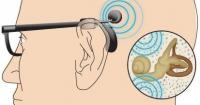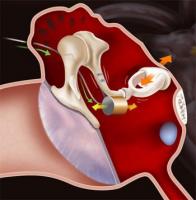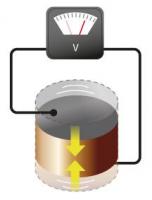Aides auditives à conduction osseuse
Conception : Benjamin Chaix Antoine Lorenzi
Le son se propage dans l’air jusqu’au tympan puis il est transformé en vibration mécanique par le système tympano ossiculaire. Dans le cas où ce cheminement est rompu, on recourt aux aides auditives à conduction osseuse. En utilisant les propriétés naturelles de conduction de l’os, elles permettent de shunter l’oreille externe et moyenne et stimuler directement les cellules sensorielles de la cochlée.
Lunettes à conduction osseuse
Fonctionnement
Le microphone, le processeur, et le vibrateur se répartissent le long des branches d’une paire de lunette. En avant, le microphone capte le son et le transmet sous forme d’un signal électrique au processeur. Suite à cela, le signal traité et amplifié met en vibration un vibrateur appliqué en arrière sur l’os de la mastoïde. Le vibrateur peut être assimilé à un écouteur pour lequel la membrane aurait été remplacée par une plaque vibrant sous l’impulsion des variations de courant électrique.

Indications
Essentiellement destinées aux surdités de transmissions, ce dispositif peut également être préconisé pour des surdités de perception ou mixtes légères à moyennes pour lesquelles l’appareillage en conduction aérienne n’est pas envisageable (aplasie du pavillon et/ou du conduit externe, otorrhée chronique, otospongiose avancée, tympanosclérose, cholestéatome).
Avantages et inconvénients
L’avantage de ces systèmes et l’aspect non invasif et la facilité de leurs mises en place. En revanche, le traitement du son, la bande passante et la puissance du vibrateur sont limités. De plus, l’efficacité de ces dispositifs dépend fortement de la surface de contact avec l’os, l’épaisseur de la peau mais encore la force de serrage parfois insuffisante.
Aides auditives à ancrage osseux
Fonctionnement
Une « vis » en titane de quelques millimètres est placée dans l’os de la mastoïde. Elle est constituée de deux parties : la fixture ancré sur l’os sur laquelle vient se fixer le pilier qui dépasse légèrement de la peau. Le microphone et le microprocesseur se positionne, quant à eux, sur le pilier. Ainsi, le son transformé en vibration est transmis directement à l’oreille interne via le système « vis-pilier » qui fait office de passerelle.
Indications
Tout comme les lunettes à conduction osseuse, l’appareillage conventionnel en conduction aérienne sera toujours privilégié s’il est possible. Sinon, certaines surdités de transmission, de perception ou mixtes légères à moyennes peuvent bénéficier de cette aide. Elle s’adresse à des adultes mais également des enfants dès l’âge de cinq ans par la mise en place d’un bandeau qui assure le contact entre le vibrateur et l’os.
Elle peut également être proposée lorsque la chirurgie de l’oreille moyenne ne peut être réalisée, ou risque de ne pas être efficace. Enfin, dans le cas d’une surdité sévère à profonde, elle peut être utilisée en système CROS afin d’apporter des informations complémentaires à l’oreille controlatérale saine.
Avantages et inconvénients
Le pilier en titane limite les risques d’infection cutanée et son ancrage dans l’os limite les contraintes liées à l’épaisseur de la peau, la surface et la force de contact avec la peau. De cette manière, le son restitué est de meilleure qualité et la puissance accrue.
Les inconvénients majeurs sont la chirurgie bien qu’elle soit légère et les précautions à prendre pour éviter les infections cutanées. De plus, la bande passante et les traitements du son sont limités même s’ils s’améliorent.
Les implants d’oreille moyenne
Fonctionnement
Comme les deux aides auditives décrites auparavant, le son est capté par un microphone externe puis traité via un processeur. A la différence, le signal électrique transmet l’information à un vibrateur qui peut être de deux types :

Electromagnétique : Lorsqu’on met sous tension une bobine dans lequel est placé un aimant permanent, les forces magnétiques induites engendrent le mouvement de la bobine. En effet, lorsque le courant circule dans un sens, les forces magnétiques repoussent la bobine vers l’extérieur, inversement quand le courant circule dans l’autre sens. C’est le même principe qu’un haut-parleur électrodynamique,

Piézoélectrique : Un matériau piézoélectrique à la propriété intrinsèque de se déformer lorsqu’il est sous tension. Ainsi, en gérant le courant on contrôle ses déformation et, par extension, la vibration.
Ces vibrateurs peuvent être fixé à différents endroits de la chaine ossiculaire : marteau, apophyse de l’enclume, branche descendante de l’enclume (le plus courant), ou encore sur un piston après avoir enlevé l’étrier. De cette manière, la vibration induite amplifie les mouvements naturels de la chaîne ossiculaire.
Indications
Lorsque l’appareillage conventionnel n’est pas envisageable ou non supporté, l’implant d’oreille moyenne peut être une alternative. Ils représentent une opportunité pour les malentendants adultes atteints de surdités de transmission, perception ou mixtes moyennes à sévères bilatérales et pour lesquels le complexe tympano-ossiculaire est intègre.
Avantages et inconvénients
L’amplification des mouvements naturels de la chaîne ossiculaire représente le principal intérêt de cette aide auditive. Ainsi, la restitution des fréquences est meilleure.
En revanche, la contrainte majeure est la chirurgie nécessaire pour la fixation du vibrateur sur la chaîne ossiculaire, dont l’intégrité est essentielle pour l’efficacité de l’implant.